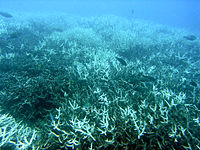
Photo from wikipedia
Coral restoration is rapidly becoming a mainstream strategic reef management response to address dramatic declines in coral cover worldwide. Restoration success can be defined as enhanced reef functions leading to… Click to show full abstract
Coral restoration is rapidly becoming a mainstream strategic reef management response to address dramatic declines in coral cover worldwide. Restoration success can be defined as enhanced reef functions leading to improved ecosystem services, with multiple benefits at socio-ecological scales. However, there is often a mismatch between the objectives of coral restoration programs and the metrics used to assess their effectiveness. In particular, the scales of ecological benefits currently assessed are typically limited in both time and space, often being limited to short-term monitoring of the growth and survival of transplanted corals. In this paper, we explore reef-scale responses of coral assemblages to restoration practices applied in four well-established coral restoration programs. We found that hard coral cover and structural complexity were consistently greater at restored compared to unrestored (degraded) sites. However, patterns in coral diversity, coral recruitment, and coral health among restored, unrestored, and reference sites varied across locations, highlighting differences in methodologies among restoration programs. Altogether, differences in program objectives, methodologies, and the state of nearby coral communities were key drivers of variability in the responses of coral assemblages to restoration. The framework presented here provides guidance to improve qualitative and quantitative assessments of coral restoration efforts and can be applied to further understanding of the role of restoration within resilience-based reef management.
Journal Title: Diversity
Year Published: 2020
Link to full text (if available)
Share on Social Media: Sign Up to like & get
recommendations!